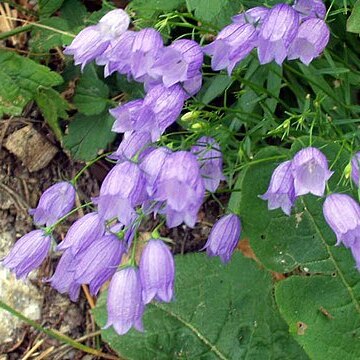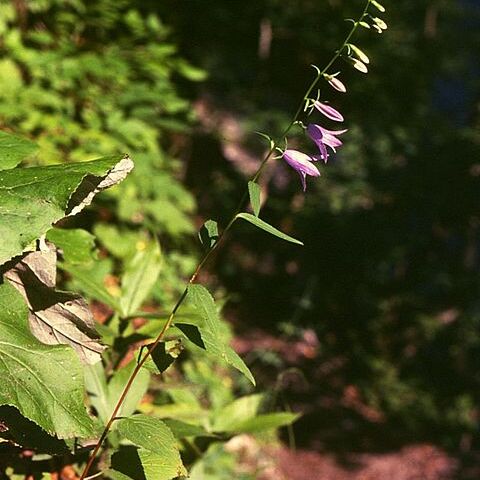Perennial or less often annual or biennial herbs, rarely lianas (not in Australia), shrubs (not in Australia), or trees (not in Australia), with milky latex, monoecious, rarely gynodioecious (not in Australia) or dioecious; stems simple or branched, sometimes rhizomatous or acaulescent (not in Australia). Leaves alternate, rarely opposite, whorled or rosulate, simple to pinnate, petiolate or sessile, sometimes sheathing; stipules absent. Inflorescences appearing racemose, paniculate, spicate, umbellate (not in Australia) or capitate (not in Australia) and composed of cymose units or flowers solitary, terminal or axillary, bracteate or not; bracts when present foliose or reduced. Flowers bisexual or rarely unisexual, actinomorphic or zygomorphic, with proterandrous secondary pollen presentation, usually with a hypanthium, often resupinate. Sepals fused, (3–) 5 (–10), valvate, sometimes with a reflexed appendage in each sinus (not in Australia). Petals fused, (4–) 5 (–10), valvate. Stamens equal in number as petals and alternating with petals, epipetalous or not; filaments free or fused; anthers free or fused, 2-locular, dehiscing by longitudinal slits. Ovary inferior to superior, (1–) 2–5 (–10)-carpellate; placentation axile, rarely parietal (not in Australia), basal (not in Australia) or apical (not in Australia); ovules numerous; style 1; stigmas equal in number as locules. Fruit a pyxis (not in Australia), loculicidal or poricidal capsule, berry, schizocarp (not in Australia), or dry and indehiscent (not in Australia); seeds small, numerous, with copious endosperm.
Annual or perennial herbs, subshrubs, or rarely small shrubs, laticiferous. Leaves alternate, rarely opposite, simple, entire, dentate to incised or rarely variously lobed, exstipulate. Inflorescences generally cymose, panicle-, raceme-, spike-or head-like, or flowers solitary. Flowers bisexual, usually protandrous, regular, (3–)5(–10)-merous, mostly with a bract and 2 bracteoles. Calyx ± adnate to the ovary; lobes usually free, persistent, valvate. Petals connate to various degrees, sometimes almost free, valvate in bud. Stamens alternating with the corolla-lobes, free or rarely adnate to the corolla; anthers very rarely entirely or partly connate, introrse; filaments usually dilated at the base. Ovary ± inferior, rarely superior, 2–10-locular; ovules few-many, anatropous, on axile placentas; style 1, furnished with pollen-collecting hairs on and usually below the style-lobes. Fruit capsular, variously dehiscing by apical or lateral valves or pores, or ± baccate. Seeds 1-many, albuminous; embryo straight, terete
Ovary ± inferior, rarely superior, 2–10–locular; ovules few–many, anatropous, on axile placentas; style 1, furnished with pollen–collecting hairs on and usually below the style–lobes
Stamens alternating with the corolla–lobes, free or rarely adnate to the corolla; anthers very rarely entirely or partly connate, introrse; filaments usually dilated at the base
Stamens as many as the corolla-lobes and alternate with them, inserted towards the base of the corolla or the disk; anthers free, 2-celled, opening lengthwise
Flowers hermaphrodite, usually protandrous, regular, (3–) 5(–10)–merous, mostly with a bract and 2 bracteoles
Leaves alternate, rarely opposite, simple, entire, dentate to incised or rarely variously lobed, exstipulate
Inflorescences generally cymose, panicle–, raceme–, spike– or head–like, or flowers solitary
Fruit capsular, variously dehiscing by apical or lateral valves or pores, or 4; baccate
Calyx –{_ adnate to the ovary; lobes usually free, persistent, valvate in bud
Annual or perennial herbs, subshrubs, or rarely small shrubs, laticiferous
Petals connate to various degrees, sometimes almost free, valvate in bud
Ovary inferior or rarely superior, 2-10-celled, with axile placentas
Corolla gamopetalous, tubular or campanulate, lobes valvate
Leaves alternate, rarely opposite, simple; stipules absent
Herbs to small trees, nearly always with milky juice
Seeds 1–many, albuminous; embryo straight, terete
Calyx-tube adnate to the ovary, 3-10-lobed
Flowers hermaphrodite, actinomorphic
Fruit capsular or baccate
Ovules mostly numerous


